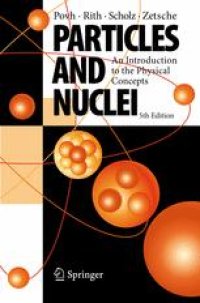
Ebook: Particles and Nuclei: An Introduction to the Physical Concepts
Author: Professor Dr. Bogdan Povh Professor Dr. Klaus Rith Dr. Christoph Scholz Dr. Frank Zetsche (auth.)
- Tags: Elementary Particles and Nuclei, Quantum Physics, Atoms Molecules Clusters and Plasmas
- Year: 2006
- Publisher: Springer Berlin Heidelberg
- Language: English
- pdf
This well-known introductory textbook gives a uniform presentation of nuclear and particle physics from an experimental point of view.
The new edition has been extensively revised and updated.
The first part, Analysis, is devoted to disentangling the substructure of matter. This part shows that experiments designed to uncover the substructures of nuclei and nucleons have a similar conceptual basis, and lead to the present picture of all matter being constructed from a small number of elementary building blocks and a small number of fundamental interactions.
The second part, Synthesis, shows how the elementary particles may be combined to build hadrons and nuclei. The fundamental interactions, which are responsible for the forces in all systems, become less and less evident in increasingly complex systems. Such systems are in fact dominated by many-body phenomena. A section on neutrino oscillations and one on nuclear matter at high temperatures bridge the field of "nuclear and particle physics" and "modern astrophysics and cosmology".
New developments are covered, e. g. in sections on the double beta decay including a discussion of the possibility for a neutrinoless decay and its implications for the standard model. The concise text is based on lectures held at the University of Heidelberg. It has been translated into many languages and has become a standard reference for advanced undergraduate and graduate courses and includes numerous exercises with worked answers.
This well-known introductory textbook gives a uniform presentation of nuclear and particle physics from an experimental point of view.
The new edition has been extensively revised and updated.
The first part, Analysis, is devoted to disentangling the substructure of matter. This part shows that experiments designed to uncover the substructures of nuclei and nucleons have a similar conceptual basis, and lead to the present picture of all matter being constructed from a small number of elementary building blocks and a small number of fundamental interactions.
The second part, Synthesis, shows how the elementary particles may be combined to build hadrons and nuclei. The fundamental interactions, which are responsible for the forces in all systems, become less and less evident in increasingly complex systems. Such systems are in fact dominated by many-body phenomena. A section on neutrino oscillations and one on nuclear matter at high temperatures bridge the field of "nuclear and particle physics" and "modern astrophysics and cosmology".
New developments are covered, e. g. in sections on the double beta decay including a discussion of the possibility for a neutrinoless decay and its implications for the standard model. The concise text is based on lectures held at the University of Heidelberg. It has been translated into many languages and has become a standard reference for advanced undergraduate and graduate courses and includes numerous exercises with worked answers.
Content:
Front Matter....Pages I-XII
Hors d’?uvre....Pages 1-7
Front Matter....Pages 9-9
Global Properties of Nuclei....Pages 11-23
Nuclear Stability....Pages 25-40
Scattering....Pages 41-52
Geometric Shapes of Nuclei....Pages 53-71
Elastic Scattering off Nucleons....Pages 73-82
Deep Inelastic Scattering....Pages 83-95
Quarks, Gluons, and the Strong Interaction....Pages 97-111
Particle Production in e+e? Collisions....Pages 113-126
Phenomenology of the Weak Interaction....Pages 127-150
Exchange Bosons of the Weak Interaction....Pages 151-163
The Standard Model....Pages 165-168
Front Matter....Pages 169-169
Quarkonia....Pages 171-187
Mesons Made from Light Quarks....Pages 189-199
The Baryons....Pages 201-227
The Nuclear Force....Pages 229-243
The Structure of Nuclei....Pages 245-284
Collective Nuclear Excitations....Pages 285-309
Nuclear Thermodynamics....Pages 311-336
Many-Body Systems in the Strong Interaction....Pages 337-340
Back Matter....Pages 341-391
Erratum....Pages 393-397
This well-known introductory textbook gives a uniform presentation of nuclear and particle physics from an experimental point of view.
The new edition has been extensively revised and updated.
The first part, Analysis, is devoted to disentangling the substructure of matter. This part shows that experiments designed to uncover the substructures of nuclei and nucleons have a similar conceptual basis, and lead to the present picture of all matter being constructed from a small number of elementary building blocks and a small number of fundamental interactions.
The second part, Synthesis, shows how the elementary particles may be combined to build hadrons and nuclei. The fundamental interactions, which are responsible for the forces in all systems, become less and less evident in increasingly complex systems. Such systems are in fact dominated by many-body phenomena. A section on neutrino oscillations and one on nuclear matter at high temperatures bridge the field of "nuclear and particle physics" and "modern astrophysics and cosmology".
New developments are covered, e. g. in sections on the double beta decay including a discussion of the possibility for a neutrinoless decay and its implications for the standard model. The concise text is based on lectures held at the University of Heidelberg. It has been translated into many languages and has become a standard reference for advanced undergraduate and graduate courses and includes numerous exercises with worked answers.
Content:
Front Matter....Pages I-XII
Hors d’?uvre....Pages 1-7
Front Matter....Pages 9-9
Global Properties of Nuclei....Pages 11-23
Nuclear Stability....Pages 25-40
Scattering....Pages 41-52
Geometric Shapes of Nuclei....Pages 53-71
Elastic Scattering off Nucleons....Pages 73-82
Deep Inelastic Scattering....Pages 83-95
Quarks, Gluons, and the Strong Interaction....Pages 97-111
Particle Production in e+e? Collisions....Pages 113-126
Phenomenology of the Weak Interaction....Pages 127-150
Exchange Bosons of the Weak Interaction....Pages 151-163
The Standard Model....Pages 165-168
Front Matter....Pages 169-169
Quarkonia....Pages 171-187
Mesons Made from Light Quarks....Pages 189-199
The Baryons....Pages 201-227
The Nuclear Force....Pages 229-243
The Structure of Nuclei....Pages 245-284
Collective Nuclear Excitations....Pages 285-309
Nuclear Thermodynamics....Pages 311-336
Many-Body Systems in the Strong Interaction....Pages 337-340
Back Matter....Pages 341-391
Erratum....Pages 393-397
....